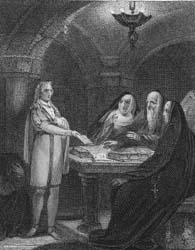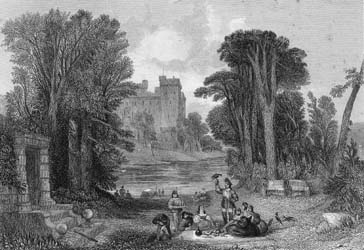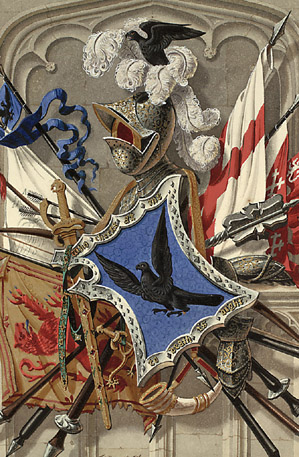|
|
Home | Corson
Collection | Biography | Works | Image
Collection | Recent
Publications | Portraits | Correspondence | Forthcoming
Events | Links | E-Texts | Contact
Marmion
First Edition, First Impression:
Marmion; A Tale of Flodden Field. By Walter Scott, Esq.
Edinburgh: Printed by J. Ballantyne and Co. For Archibald Constable
and Company, Edinburgh; and William Miller, and John Murray, London,
1808.
Composition | Synopsis | Reception | Links
Composition
In late 1806 Scott began to write a poem on one of the
greatest disasters in Scottish history, the battle of Flodden
Field (1513), where an English army inflicted heavy losses
on the Scots, killing King James IV and most of his nobles.
One of Scott's correspondents, Anna Seward queried whether
it might not be too offensive to Scottish pride to commemorate
such an event in verse. Scott replied that at Flodden 'all
was lost but our honour', making it an eminently
suitable subject for a poet (letter of February 20, 1807).
Much of the poem was written at Ashestiel,
and the epistles to friends which preface each of the six
cantos describe the effects of the changing seasons upon
its scenery. Work on the poem was delayed by Scott's editorial
commitments on the Works of John Dryden and by his
efforts to disentangle the financial affairs of his brother,
Tom. It was finally completed on January 22, 1808, and
published on February 22.
Back to top
|
|
Synopsis
 The
poem concerns the designs of Lord Marmion, a favourite of Henry
VIII, upon a wealthy heiress, Clara de Clare. In order to remove
her fiancé, Sir Ralph De Wilton, he forges a letter implicating
him in a treasonable plot. In this, he is assisted by his mistress,
Constance De Beverley, a perjured nun, who thus hopes to reconquer
his affection. De Wilton claims the right to defend his honour
in combat but is defeated by Marmion and forced to flee abroad.
In order to escape Marmion, Clara takes refuge in a convent. Marmion
abandons Constance who is condemned to death for breaking her vows
and walled up alive in the convent of St. Hilda on the Holy Island
at Lindisfarne. Before her death, she consigns to the Abbess documents
proving De Wilton's innocence. De Wilton, meanwhile, has re-entered
the country disguised as a pilgrim. He follows Marmion to Scotland
where he has gone to make overtures for peace at the Scottish court
(and to assess the Scots' battle-readiness). The Abbess finds De
Wilton in Edinburgh and hands over the documents. De Wilton shows
these to Marmion's host, the Earl of Angus, who equips him with
armour and readmits him to the order of knighthood. The battle
of Flodden Field is fought before De Wilton can proceed further
against Marmion. Marmion is killed in the battle. De Wilton fights
with distinction, regains his honour and estates, and marries Clara. The
poem concerns the designs of Lord Marmion, a favourite of Henry
VIII, upon a wealthy heiress, Clara de Clare. In order to remove
her fiancé, Sir Ralph De Wilton, he forges a letter implicating
him in a treasonable plot. In this, he is assisted by his mistress,
Constance De Beverley, a perjured nun, who thus hopes to reconquer
his affection. De Wilton claims the right to defend his honour
in combat but is defeated by Marmion and forced to flee abroad.
In order to escape Marmion, Clara takes refuge in a convent. Marmion
abandons Constance who is condemned to death for breaking her vows
and walled up alive in the convent of St. Hilda on the Holy Island
at Lindisfarne. Before her death, she consigns to the Abbess documents
proving De Wilton's innocence. De Wilton, meanwhile, has re-entered
the country disguised as a pilgrim. He follows Marmion to Scotland
where he has gone to make overtures for peace at the Scottish court
(and to assess the Scots' battle-readiness). The Abbess finds De
Wilton in Edinburgh and hands over the documents. De Wilton shows
these to Marmion's host, the Earl of Angus, who equips him with
armour and readmits him to the order of knighthood. The battle
of Flodden Field is fought before De Wilton can proceed further
against Marmion. Marmion is killed in the battle. De Wilton fights
with distinction, regains his honour and estates, and marries Clara.
Back to top
Reception
Marmion was an even greater commercial success than The
Lay of the Last Minstrel The first (exorbitantly priced)
edition of 2,000 copies sold out in under two months, and by
the end of May 1808 the poem was already into its third edition.
Frequently reprinted, Marmion remained a best-seller
throughout the nineteenth century.
Critical response, however, was a good deal cooler. There was
widespread censure of the opening epistles, which were felt to
intrude upon the narrative. The plot was judged obscure and, in
these pre-Byronic days, the character of Marmion, a mixture of
villainy and magnanimity, was felt to be unsuitable for a poetic
hero. A particularly pointed critique was offered by Francis Jeffrey
in the Edinburgh Review. For Jeffrey, there was too much
in he poem that was 'flat and tedious' where Scott appeared merely
to be vaunting his historical knowledge. He objected to the anachronistic
vogue for chivalry that Scott had fostered and, as an advocate
of peace with France, bridled at the bellicose sentiments of the
introductory epistles. None of this, however, hindered Scott's
mounting vogue. This had now reached such a height that Constable
was able to commission a portrait of the poet from the celebrated
painter Sir Henry
Raeburn.
Back to top

Links
Back to Index of Works
Last updated: 19-Dec-2011
© Edinburgh University Library
|
|


 The
poem concerns the designs of Lord Marmion, a favourite of Henry
VIII, upon a wealthy heiress, Clara de Clare. In order to remove
her fiancé, Sir Ralph De Wilton, he forges a letter implicating
him in a treasonable plot. In this, he is assisted by his mistress,
Constance De Beverley, a perjured nun, who thus hopes to reconquer
his affection. De Wilton claims the right to defend his honour
in combat but is defeated by Marmion and forced to flee abroad.
In order to escape Marmion, Clara takes refuge in a convent. Marmion
abandons Constance who is condemned to death for breaking her vows
and walled up alive in the convent of St. Hilda on the Holy Island
at Lindisfarne. Before her death, she consigns to the Abbess documents
proving De Wilton's innocence. De Wilton, meanwhile, has re-entered
the country disguised as a pilgrim. He follows Marmion to Scotland
where he has gone to make overtures for peace at the Scottish court
(and to assess the Scots' battle-readiness). The Abbess finds De
Wilton in Edinburgh and hands over the documents. De Wilton shows
these to Marmion's host, the Earl of Angus, who equips him with
armour and readmits him to the order of knighthood. The battle
of Flodden Field is fought before De Wilton can proceed further
against Marmion. Marmion is killed in the battle. De Wilton fights
with distinction, regains his honour and estates, and marries Clara.
The
poem concerns the designs of Lord Marmion, a favourite of Henry
VIII, upon a wealthy heiress, Clara de Clare. In order to remove
her fiancé, Sir Ralph De Wilton, he forges a letter implicating
him in a treasonable plot. In this, he is assisted by his mistress,
Constance De Beverley, a perjured nun, who thus hopes to reconquer
his affection. De Wilton claims the right to defend his honour
in combat but is defeated by Marmion and forced to flee abroad.
In order to escape Marmion, Clara takes refuge in a convent. Marmion
abandons Constance who is condemned to death for breaking her vows
and walled up alive in the convent of St. Hilda on the Holy Island
at Lindisfarne. Before her death, she consigns to the Abbess documents
proving De Wilton's innocence. De Wilton, meanwhile, has re-entered
the country disguised as a pilgrim. He follows Marmion to Scotland
where he has gone to make overtures for peace at the Scottish court
(and to assess the Scots' battle-readiness). The Abbess finds De
Wilton in Edinburgh and hands over the documents. De Wilton shows
these to Marmion's host, the Earl of Angus, who equips him with
armour and readmits him to the order of knighthood. The battle
of Flodden Field is fought before De Wilton can proceed further
against Marmion. Marmion is killed in the battle. De Wilton fights
with distinction, regains his honour and estates, and marries Clara. 